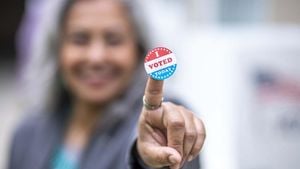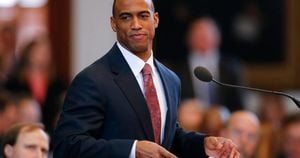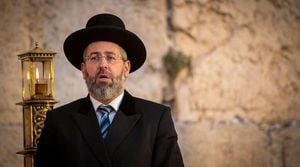Donald Trump is making headlines once again as the former president and current presidential candidate gears up for his 2024 campaign with notable decisions on his Cabinet appointments. Since announcing his bid for the presidency, Trump has swiftly moved to shape his administration, focusing on key appointments aimed at ensuring strong support from the Republican Party as he inches closer to the election.
This past week, Trump made several pivotal Cabinet selections, including naming Pam Bondi, the former Attorney General of Florida, to lead the Department of Justice after his initial pick, Matt Gaetz, withdrew his nomination. Gaetz’s exit was reportedly due to pushback from party colleagues, which highlighted the contentious atmosphere surrounding some of Trump’s recent choices. Bondi is well-regarded within Trump’s inner circle, having represented him at his first impeachment Senate trial, making her nomination appear as both strategic and politically motivated.
Meanwhile, Trump did not waste any time filling other important positions. He has tapped Brooke Rollins, CEO of the America First Policy Institute, as his choice for Secretary of Agriculture. Rollins’ background aligns closely with Trump’s agenda, particularly his push to prioritize American farmers and agricultural interests. This pattern of prioritizing allies from his previous administration signals Trump’s intention to reinforce his policies rather than implement major shifts from his past governance.
Adding to the excitement of his Cabinet announcements, Trump selected Scott Bessent, a hedge fund manager, for the role of Treasury Secretary. This choice embodies Trump’s inclination to surround himself with business-minded advisors, hearkening back to his first term when economic issues were heavily emphasized. This list of appointments showcases Trump’s effort to quickly align his administration with individuals who possess significant influence and share his political philosophy.
Freshly elected Senate member JD Vance is taking on the role of introducing Trump’s nominees to his fellow Senate Republicans. Vance, who was elected from Ohio and has previously voiced strong support for Trump’s agendas, is actively working to rally support among GOP senators to facilitate quick confirmations. His efforts are expected to culminate with meetings between Republicans and Trump’s nominees, which include Gaetz for the Department of Justice, Hegseth for the Department of Defense, and Rep. Stefanik for the United Nations.
Yet, not all members of the Republican Party are wholly on board with Trump’s selections. Senator Lisa Murkowski of Alaska and Senator Susan Collins of Maine have both expressed concerns about Gaetz’s appointment, raising questions about the broader consensus among Republicans on these nominees. This division within the GOP may complicate Trump’s goals of securing timely confirmations, raising the stakes as he prepares for the upcoming election.
Adding to the intrigue, Trump’s latest nominations reflect his ambitions not just for personnel alignment, but also for strategic positioning as the campaign season heats up. With numerous key roles already filled and more nominations expected soon, Trump is evidently working to position himself to respond effectively to various challenges, both domestic and international. His rapid pace of appointments also aims to portray organizational readiness and efficiency, which he hopes will resonate with voters.
The choice of nominees also mirrors Trump’s commitment to maintaining his core messaging and operational ethos from his first term, emphasizing America first policies. By aligning with individuals who share similar visions, such as pushing back against international regulations and prioritizing American business interests, Trump aims to solidify his electoral base as he moves forward with his campaign initiatives.
Trump’s transition team is clearly motivated to lay the groundwork for swift confirmations and effective governance. A spokesperson for the transition expressed intentions to accelerate the process, indicating the team expects forthcoming meetings to solidify support for key choices. With additional visits to Capitol Hill planned beyond the Thanksgiving recess, Trump’s engagement with Senate allies seems set to ramp up, as he seeks to build momentum behind his administration.
It’s important to note how Trump’s approach to filling these positions highlights his broader strategy for governance and leadership style. Unlike previous administrations where nominees were selected based on bipartisan appeal or extensive vetting processes, Trump appears to be positioning his Cabinet selections as loyal allies first and experienced administrators second.
The latest Cabinet announcements come alongside Trump’s meetings with key figures, including NATO Secretary General Mark Rutte, to discuss global issues. These interactions reiterate not only Trump’s commitment to securing America's interests abroad but also spotlight the direction he intends his administration to take, particularly concerning foreign policy matters.
Current events are corroborated by high stakes as the 2024 election approaches. Each appointment signifies Trump’s bid to reshape his administration to echo the values and priorities he championed previously. Trump’s focus on key positions within his Cabinet is telling of his strategy as he prepares to face not just Democrats, but also potential challenges from within his party.
Trump’s selections signal what might be viewed as the resumption of his previous administration’s agenda, aiming to build rapport with his support base, which largely remains intact. The upcoming weeks are expected to be telling as Vance continues his networking efforts, and discussions around the nominees evolve. Despite the undercurrents of opposition, the alignment between Trump and his selected Cabinet members affirms his vision for America.
With all eyes on the upcoming elections and Trump’s Cabinet selections swaying potential votes, the American political arena is bracing itself for the ramifications of these appointments. While the key challenges posed by both political adversaries and international partnerships are immanent, Trump’s strategic lineup of loyal supporters is preparing to navigate the road ahead as the 2024 race heats up and political engagements intensify.
The anticipation builds as Trump’s administration prepares for the future, and the selections of Chapman and Bondi highlight his strategy to hug close to allies and supporters from his previous tenure. The political maneuverings are far from over, and as the year continues, the impact of these key appointments will likely echo through the GOP and influence the operational plans leading up to the elections.



